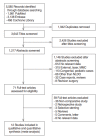A Systematic Review of Benefit of Silicone Intubation in Endoscopic Dacryocystorhinostomy
- PMID: 29649861
- PMCID: PMC5951072
- DOI: 10.21053/ceo.2018.00031
A Systematic Review of Benefit of Silicone Intubation in Endoscopic Dacryocystorhinostomy
Abstract
Objectives: Insertion of a silicone stent during endoscopic dacryocystorhinostomy (DCR) is the most common procedure to prevent rhinostomy closure. It has been claimed that silicone intubation improves the surgical outcomes of endoscopic DCR. However, many reports have documented an equally high success rate for surgery without silicone intubation. Accordingly, we conducted a systematic review and meta-analysis to clarify the outcomes of endoscopic DCR with and without silicone intubation and determine whether silicone intubation is actually beneficial for patients.
Methods: PubMed, Embase, and Cochrane Library databases were searched to identify relevant controlled trials evaluating endoscopic DCR with and without silicone intubation. The search was restricted to English articles published between January 2007 and December 2016. Relevant articles were reviewed to obtain information pertaining to interventions and outcomes. We also performed a meta-analysis of the relevant literature.
Results: In total, 1,216 patients included in 12 randomized controlled trials were pooled. A total of 1,239 endoscopic DCR procedures were performed, and silicone stents were used in 533 procedures. The overall success rate for endoscopic DCR was 91.9% (1,139/1,239), while the success rates with and without silicone intubation were 92.9% (495/533) and 91.2% (644/706), respectively. There was no statistically significant heterogeneity among the included studies. A meta-analysis using a fixed-effects models showed no significant difference in the success rate between endoscopic DCR with silicone intubation and that without silicone intubation (OR, 1.38; 95% CI, 0.89 to 2.12; P=0.148; z=1.45). Furthermore, there were no significant differences with regard to surgical complications such as synechia, granulation, and postoperative bleeding.
Conclusion: The findings of our meta-analysis suggest that the success rate and postoperative complication rate for endoscopic DCR is not influenced by the use of silicone intubation during the procedure.
Keywords: Dacryocystorhinostomy; Endoscopy; Failure; Meta-Analysis; Silicones.
Conflict of interest statement
No potential conflict of interest relevant to this article was reported.
Figures








Similar articles
-
Silicone intubation and endoscopic dacryocystorhinostomy: a meta-analysis.J Otolaryngol Head Neck Surg. 2010 Dec;39(6):710-3. J Otolaryngol Head Neck Surg. 2010. PMID: 21144368
-
A meta-analysis of primary dacryocystorhinostomy with and without silicone intubation.Can J Ophthalmol. 2011 Dec;46(6):521-7. doi: 10.1016/j.jcjo.2011.09.008. Can J Ophthalmol. 2011. PMID: 22153640
-
Comparing the Success Rate of Dacryocystorhinostomy With and Without Silicone Intubation: A Trial Sequential Analysis of Randomized Control Trials.Sci Rep. 2017 May 16;7(1):1936. doi: 10.1038/s41598-017-02070-y. Sci Rep. 2017. PMID: 28512307 Free PMC article.
-
The Clinical Efficacy of Silicone Stents for Endoscopic Dacryocystorhinostomy: A Meta-Analysis.Clin Exp Otorhinolaryngol. 2018 Sep;11(3):151-157. doi: 10.21053/ceo.2017.01781. Epub 2018 Mar 30. Clin Exp Otorhinolaryngol. 2018. PMID: 29590744 Free PMC article. Review.
-
Success rate of external, endonasal, and transcanalicular laser DCR with or without silicone stent intubation for NLD obstruction: a network meta-analysis of randomized controlled trials.Graefes Arch Clin Exp Ophthalmol. 2023 Dec;261(12):3369-3384. doi: 10.1007/s00417-023-06089-y. Epub 2023 May 15. Graefes Arch Clin Exp Ophthalmol. 2023. PMID: 37184641 Review.
Cited by
-
Long-term results of a balloon-assisted endoscopic approach in failed dacryocystorhinostomies.Eur Arch Otorhinolaryngol. 2022 Apr;279(4):1929-1935. doi: 10.1007/s00405-021-06975-3. Epub 2021 Jul 12. Eur Arch Otorhinolaryngol. 2022. PMID: 34251520 Free PMC article.
-
Comparison of Tranexamic acid, Remifentanil, and Hydralazine on the bleeding volume during Dacryocystorhinostomy surgery.Int J Physiol Pathophysiol Pharmacol. 2022 Jun 15;14(3):177-186. eCollection 2022. Int J Physiol Pathophysiol Pharmacol. 2022. PMID: 35891928 Free PMC article.
-
Is Stenting Really Necessary in Primary Endonasal DCR-Our Experience.Indian J Otolaryngol Head Neck Surg. 2022 Oct;74(Suppl 2):1210-1215. doi: 10.1007/s12070-020-02288-9. Epub 2021 Jan 3. Indian J Otolaryngol Head Neck Surg. 2022. PMID: 36452615 Free PMC article.
-
Endoscopic dacryocystorhinostomy with mucosal anastomosing in chronic dacryocystitis with three categories of ethmoid sinuses.Int J Ophthalmol. 2022 Nov 18;15(11):1765-1771. doi: 10.18240/ijo.2022.11.06. eCollection 2022. Int J Ophthalmol. 2022. PMID: 36404979 Free PMC article.
-
Endoscopic dacryocystorhinostomy with short-term, pushed-type bicanalicular intubation vs. pulled-type monocanalicular intubation for primary acquired nasolacrimal duct obstruction.Front Med (Lausanne). 2022 Jul 28;9:946083. doi: 10.3389/fmed.2022.946083. eCollection 2022. Front Med (Lausanne). 2022. PMID: 35966838 Free PMC article.
References
-
- Unlu HH, Toprak B, Aslan A, Guler C. Comparison of surgical outcomes in primary endoscopic dacryocystorhinostomy with and without silicone intubation. Ann Otol Rhinol Laryngol. 2002 Aug;111(8):704–9. - PubMed
-
- Leong SC, Macewen CJ, White PS. A systematic review of outcomes after dacryocystorhinostomy in adults. Am J Rhinol Allergy. 2010 Jan-Feb;24(1):81–90. - PubMed
-
- Feng YF, Cai JQ, Zhang JY, Han XH. A meta-analysis of primary dacryocystorhinostomy with and without silicone intubation. Can J Ophthalmol. 2011 Dec;46(6):521–7. - PubMed
-
- Callejas CA, Tewfik MA, Wormald PJ. Powered endoscopic dacryocystorhinostomy with selective stenting. Laryngoscope. 2010 Jul;120(7):1449–52. - PubMed
-
- Syed MI, Head EJ, Madurska M, Hendry J, Erikitola OC, Cain AJ. Endoscopic primary dacryocystorhinostomy: are silicone tubes needed? Our experience in sixty three patients. Clin Otolaryngol. 2013 Oct;38(5):406–10. - PubMed
Publication types
LinkOut - more resources
Full Text Sources
Other Literature Sources

